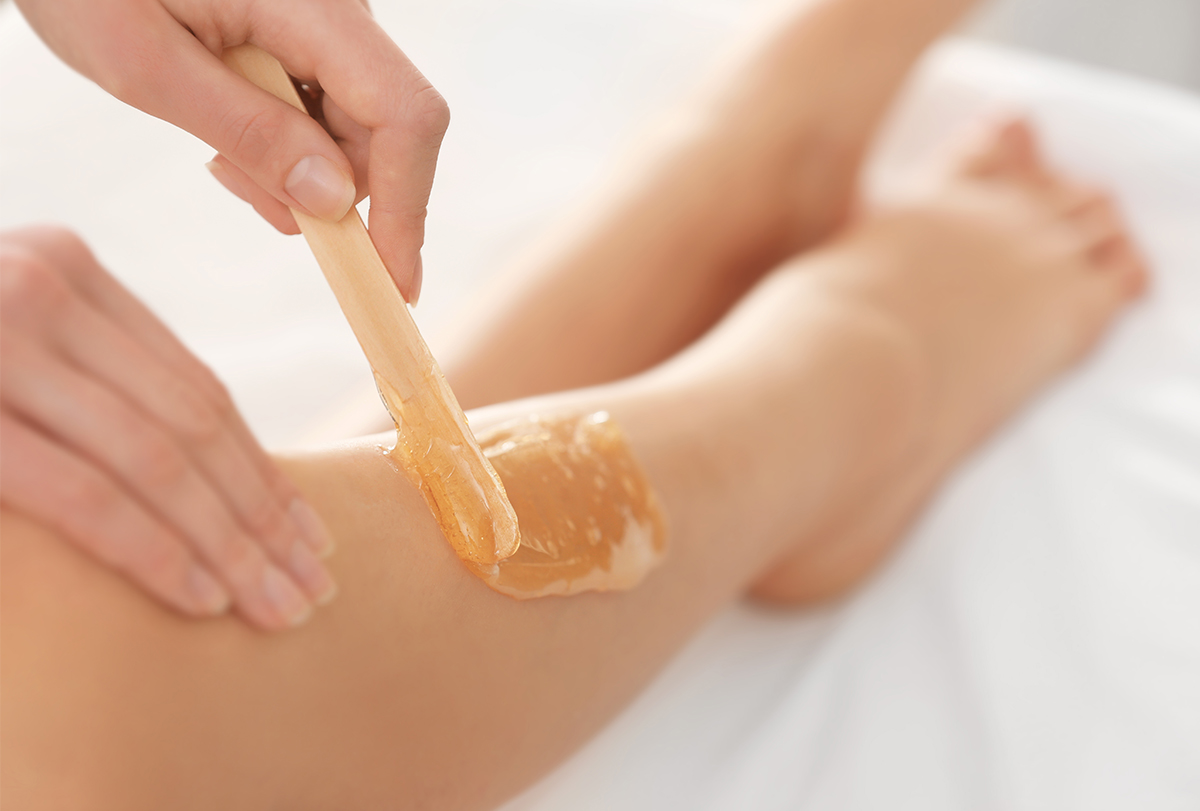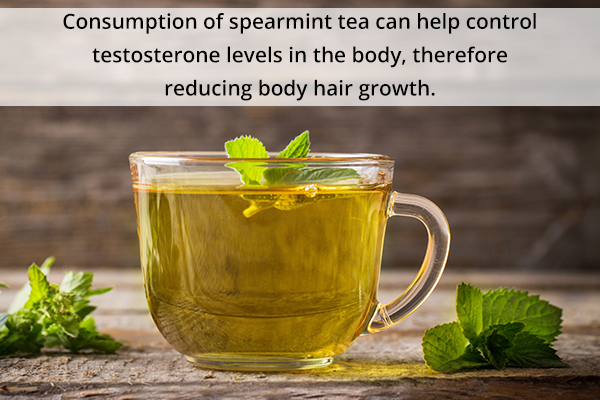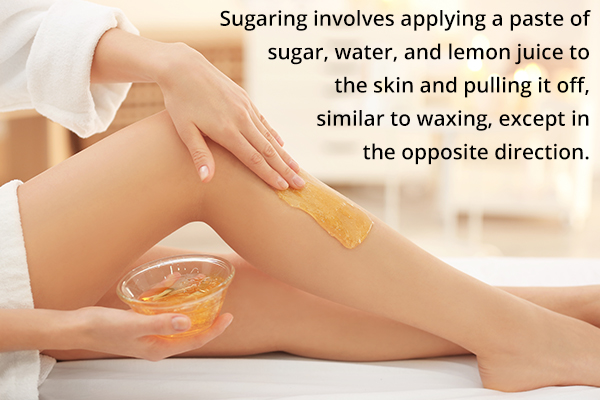In this article:
Many women experience excessive hair growth on the face, chest, back, neck, arms, and toes, known as hirsutism. (1) This condition generally affects women aged 15–45 years.

Hirsutism is however not a medical condition on its own and can occur due to genetic predisposition, use of medications such as steroids, or medical conditions that cause hormonal disbalance, including polycystic ovarian syndrome (PCOS). (2)
While hirsutism cannot be cured, there are various methods that you can use to remove unwanted hair temporarily. When combined with proper treatment on the advice of your healthcare provider, these methods may help manage the growth of thick, coarse hair to a great extent.
Temporary Methods to Remove or Reduce Unwanted Body Hair
The following at-home or professional beauty treatments can remove or reduce unwanted hair. However, keep in mind that these methods are only short-lived solutions and need to be repeated periodically.
1. Consumption of spearmint tea

Studies have shown that the consumption of spearmint tea can help control testosterone levels in the body, therefore reducing body hair growth. Thus, spearmint tea may be used for the treatment of mild hirsutism. (3)
For this, simply brew a cup of spearmint tea by adding boiling water to 1 tsp of spearmint tea leaves, allowing it to steep for 10 minutes. Drink spearmint tea two times a day for 5 days.
2. Waxing
Waxing is a popular hair removal method that strips the hair from the root. The use of warm wax helps dilate the hair follicles, while the wax sticks to the hair so that it can be pulled off.
You may see new hair growth after 3–4 weeks of waxing. However, waxing can cause pain, redness, short-term swelling, and ingrown hair.
Note: Avoid waxing your face, and don’t use it when you are on isotretinoin or prescription acne creams such as Retin-A. (4) It is best to consult a professional for waxing and avoid performing it at home.
3. Sugaring

Sugaring is another form of hair removal method that involves the use of a sugar paste made from lemon juice, water, and sugar. The paste is applied to the skin and pulled off, similar to waxing, except in the opposite direction.
The effect of sugaring also lasts for 3–4 weeks. However, it is less painful and is more skin friendly than waxing. (5) While sugaring can be performed at home, it is best to consult a professional if you aren’t skilled with the procedure. Also, avoid sugaring on your face.
4. Use of depilatory creams
Several over-the-counter depilatory creams, gels, and lotions are available that remove unwanted hair by dissolving it. They are easy to use at home, only involving the application of cream and rinsing it off after a few minutes.
Always conduct a patch test before using the cream to check for any sensitivity reaction on your skin.
5. Shaving

Shaving using a razor is another common hair removal method. However, the hair is cut off from the surface only and therefore can grow back quickly in a few days. (6)
You can perform shaving from the comfort of your home. Simply apply some shaving cream or lotion to your skin and glide a sharp razor over it.
Shaving can be done safely all over your body, including the face. However, it should be performed carefully to avoid cuts. Also note that regular shaving can increase the chances of ingrown hair and razor bumps.
6. Use of an epilator
Epilators are electronic devices that remove hair by pulling it out from the roots. An epilator works similarly to a pair of tweezers but covers a wider surface, pulling out multiple hair strands at once.
Results of epilator use can last for 3–4 weeks. However, the procedure may be painful and can cause skin redness.
Dietary Regulations to Help Curb Unwanted Body Hair

What you consume may have an effect on the growth of your body hair. The following dietary tips are suggested to aid in the management of hirsutism:
- Include antioxidant-rich fresh fruits and vegetables such as cherries, blueberries, tomatoes, spinach, broccoli, and potatoes in your diet.
- Consume plenty of water, at least 8 glasses, throughout the day.
- Increase your intake of zinc which can help increase progesterone in the body, therefore blocking androgen production. (7) Studies have also shown that zinc supplements can help treat hirsutism. It is recommended to take 30–50 mg of zinc daily post-dinner. (8) Consult your doctor on the suitability of supplements for your condition.
- Reduce your consumption of sugar and carbohydrates.
Tips That Can Help Prevent Unwanted Body Hair
In addition to getting hair removal treatments, the following tips may contribute to the better management of the unwanted hair:
- Always conduct a patch test on a part of your hand before trying any hair removal method to rule out sensitivity or allergic reactions. Discontinue use if you notice any skin irritation or a rash.
- Take a hot water bath or use a steam room before hair removal to help open the pores, therefore aiding in easier removal of the hair.
- You may benefit from managing your weight if the hirsutism is a symptom of PCOS as weight loss helps regulate the androgen levels in your body. (9)
Most-Asked Questions About Hirsutism
Can the use of N-acetyl cysteine (NAC) help manage hirsutism?

N-acetyl cysteine is often used in the treatment of PCOS to manage hormone levels in the body. Therefore, it may be helpful in managing hirsutism caused by high androgen levels as well. (10)
Can hirsutism be cured?
Hirsutism is generally a long-term or chronic condition as the underlying problems neither have an effective cure nor improve on their own.
For example, in PCOS, a woman’s estrogen and progesterone levels may improve with age, but the androgen levels remain high even after menopause, allowing the hirsutism to persist. Therefore, the treatment for hirsutism is often long term, and the problem may return once treatment is stopped.
Final Word
Hirsutism, or excessive hair growth, is generally nonproblematic on its own. However, it is a cosmetic concern for some women, potentially leading to emotional and self-esteem issues. Therefore, getting treatment for hirsutism is often recommended, especially if you have an underlying problem such as PCOS.
Besides medical treatment, you can use different hair removal methods to control the appearance of the excessive hair growth. You may consult your doctor on the best plan of treatment suitable for your particular condition and preference.

- Was this article helpful?
- YES, THANKS!NOT REALLY


